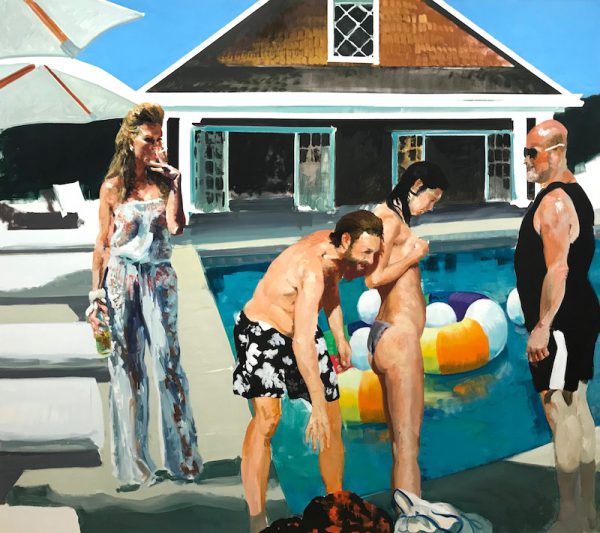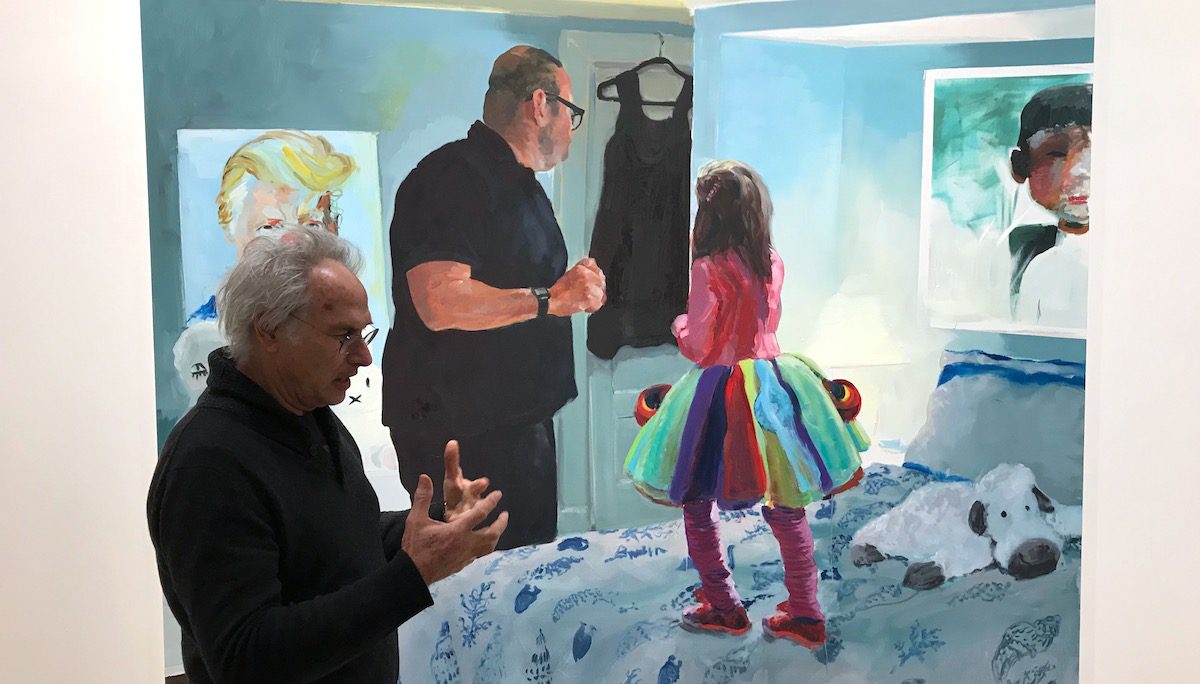The American figurative painter Eric Fischl is back in London with a new exhibition of his large narrative canvases. The artist appears to have moved galleries from Victoria Miro to the Skarstedt Gallery in St James, for this latest offering.
“My paintings are not about realism they’re about reality” – Eric Fischl
Where his last show in 2014 depicted detached spectators at Art Fairs looking at ‘blue chip’ art, Fischl has returned to his earlier explorations of suburban banality and intrigue.
Fischl is somewhat of an anomaly in the chronology of New York painting. He crashed onto the scene in the 1980s along with artists David Salle and Julian Schnabel who he has been associated with ever since. In many ways, Fischl is the more talented cousin. Painting from photographs but always stretching perspective and narrative perception, he creates a distorted reality of augmented human interaction or detachment in much the same way that Edward Hopper approached his subject matter.
There is always something absent from the connection between the canvas and the viewer. It is almost like you are only being told half the story and it’s up to you to develop the conclusion. Many of the scenarios would be challenging, even for Freud (Sigmund not Lucian).
‘Worry’ 2017 is one of the most disturbing paintings ever concocted by the artist. This includes ‘Bad Boy’ 1981 a painting of an eight year old creepily staring at a naked middle aged women as he steals from her purse and Daddy’s Girl 1983 a nude male figure hugging a young nude girl. ‘Worry’ shows the figure of a middle-aged man with a child bouncing on her bed. The bedroom door is shut, and the man is wringing his hands as he looks anxiously towards the door. What is going on here? Is this man the child’s father or a predatory Uncle Ernie? Is the action taking place sinister or innocent? Fischl leaves it up to you to piece the story together in your mind. The scenes provoked are cinematic, technicolour and so dark that you cant look for long.
When listening to the artist speak about this particular work, one concludes he’s a dark horse, not giving much away to spoil the plot. Fischl is far more interested in discussing the Donald Trump painting, in the girl’s bedroom and the scary dolls that are all looking straight at the viewer while the human figures look away. The elephant in the room almost escapes, but finally, a woman asks the artist if he is addressing issues of paedophilia in the painting’s subject matter. Fischl says That’s up to you to decide.

Other paintings are easier to handle, but all have layer upon layer of narrative depth. Jealousy, ageing beauty and death are thematic subjects addressed. One picture centers around a suburban swimming pool as male figures pay attention to a young woman, watched over by a chain-smoking former beauty queen in her 50s. In another, a middle-aged couple are having a tense moment. He reads a document she sips scotch they are void of emotion as if there is nothing more to say. Like the cover of a 1950s pulp fiction novel, the actions of the couple are being acted out before us, but if you want to know what is really happening, you’ll have to read the book.
Eric Fischl was born in New York in 1948. He graduated from the California Institute of Arts in Valencia, in 1972, and was a teacher between 1974 and 1978 at the Nova Scotia College of Art and Design in Halifax. Fischl had his first solo show, curated by Bruce W. Ferguson, at Dalhousie Art Gallery in Nova Scotia in 1975 before relocating to New York City in 1978.
Fischl works in multiple mediums such as painting, sculpture and prints, and is mostly known for his large-scale, naturalistic images of middle-class American life. His suburban upbringing provided him with a backdrop of alcoholism and a culture obsessed with image over content. Subsequently, his early work became focused on key yet truthful issues deemed repugnant by polite society. The essential underlying sexuality in his works, often portrays intimate moments that the viewer is helplessly made privy to and address the dark and disturbing undercurrents of mainstream American life. Fischl’s large human-scale figures only emphasise the voyeuristic feeling of his images and imbue them with a psychological, almost dream-like intensity. His earlier paintings are highly reminiscent of the Photorealism works of the 1960s, and during the 1980s his style expanded to fragmented images split into separate panels, which he used for paintings and etchings.
Words/Photos P C Robinson © Artlyst 2018
**** Star
Eric Fischl: Presence of an Absence 1st March – 26th May 2018 Skarstedt, 8 Bennet St., St James’s, London, SW1A 1RP

